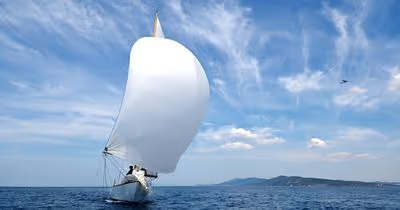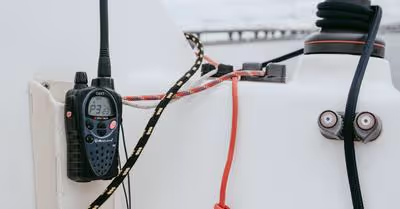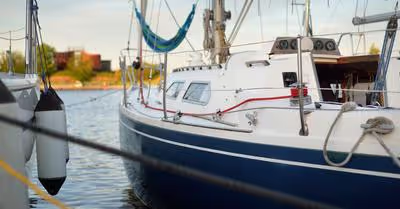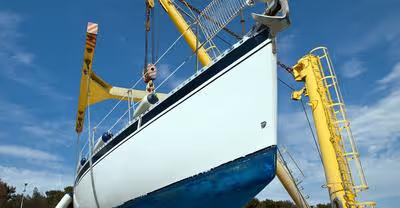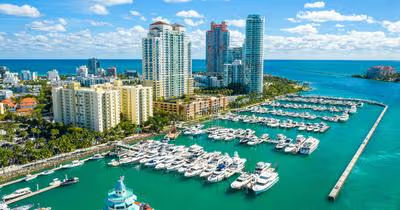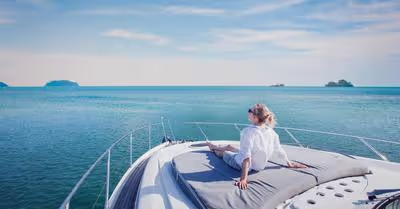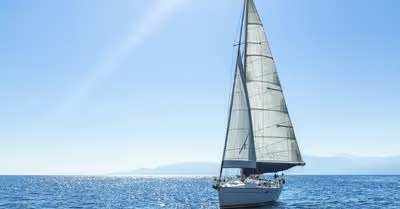Table of Contents
Sailing Costs
Let's discuss in detail the different costs of sailing.
Sailing Lessons
Some people have an inbuilt aptitude for sailing, so they take it up at an early age. Then, some grow up in families where one or both of their parents were sailors. However, if you aren't either, that doesn’t mean you don’t have sailing in your blood.
It may seem easy in the videos, but maneuvering across the ocean requires guts and a lot of training. As a sailor, you enter a space that is very unpredictable, volatile, and potentially dangerous. Therefore, you need to learn the craft before heading out.
As a beginner, you can start by reading books and watching YouTube videos. However, to fully understand the fundamentals of sailing, you need to sail a boat with a professional sailing trainer. If you have a friend or a relative that can help you out, you can cut the training cost.
Most sailing classes aren't costly, and they cost between $400 and $1500. Training costs vary depending upon the area, the training level, and the season.
The upside is you will receive official instruction, which is far superior to reading books or watching videos. Moreover, you will get hands-on experience, which will help you sail confidently. However, before you take up sailing, make sure you can swim well. If you can't swim, then enroll in swimming classes.
The Boat
Contrary to popular belief, you don’t need to buy a boat to learn how to sail. At some sailing clubs, you get the option of sharing boats. You can also find sailors looking for boat crews. Moreover, you can reach out to local yacht clubs and ask if they need crew members.
Another option is gaining membership to sites like CrewSeekers International or Saliopo.Com, and spending your vacation on a boat learning from professional sailors.
Sailboat prices can range from a couple thousand dollars to well over $100,000. The price of the boat depends upon factors like boat size, age, build, and technology. Other factors include rigging and hauling. Moreover, the kind of boat you need also plays a huge role. Do you need a liveaboard cruiser, a seaworthy boat, or a vacation boat? The season and whether you choose to sail in freshwater or salty water also heavily influence how much you’ll have to pay.
An average yacht will cost around $50,000, whereas a 26-foot boat will cost around $25000. Most 25-feet boats cost around $40,000. Of course, if you buy a used boat, the price will take a dip. If you are tight on budget, a seaworthy sailboat should be your go-to boat, as it only costs as much as $7000. If you are a sailing enthusiast with tools and DIY skills, you can cut some of the maintenance costs.
Renting VS Purchasing a Sailboat
Rental fees are variable, but renting is much less expensive than purchasing a boat. However, buying and maintaining a 14-18 foot boat is even cheaper. For example, a used sailboat costs around $7000. When not in use, you can store it in your backyard and tow it to the sailing location. These boats don’t even need an extra motor.
As far as renting a boat is concerned, several sailing clubs and firms can lend you a boat. Since you don’t own these boats, you can save yourself from the additional maintenance charges, making it much cheaper for you than owning and maintaining a boat. With renting, you also don't need to pay any docking charges.
However, before sailing, you must know how to ride a boat. If not, you will have to hire a skipper, which can be a costly affair. Just like purchasing a boat, the rent also depends upon the size of the boat, the location, and the time you will spend on the boat.
Insurance and Maintenance
Like other vehicles, boats also require annual maintenance and sometimes repairs. It is important to keep your boat in top shape to avoid expensive repairs in the long run. Some maintenance chores include painting and waxing the hull.
Moreover, some charges come with dry storage. Engines also need timely maintenance. If you can DIY, you will save some money, but it is better to hire a professional for the job.
Moreover, you cannot skimp on insurance, which costs around $350 per annum, but it depends upon the boat. Spending a few hundred dollars on insurance each year isn't too costly. However, insurance charges for luxury machines like yachts can go up to $1000 per year.
The fun fact is, the more experienced you are and the better you maintain your boat, your insurance charges will be considerably low. It is worth noting that if your boat is older than 15 years, you will have to invest in new sails, rigging, and lines.
Boats that are 24-26 feet long need an outboard motor for auxiliary power. These motors require significant maintenance to remain in top shape. Boats that are longer than 26 feet are even costlier to maintain because of bigger rigging, motors, and sails.
They also need a bigger dock space, which doesn’t come cheap. Sailing shouldn’t be an expensive hobby, but if you own a boat, it will be.
Storage and Rigging
When buying a boat, always opt for the one that is rigged. Otherwise, you will have to invest in the rigging. Depending upon rigging quality and how you use it, rigging needs to be updated once or twice a decade. The price of rigging can range from a few hundred dollars to $2000 depending upon its size and quality.
The rigging process requires ropes and some other supplies. The installation cost will spike if you bring in specialty equipment like a spinnaker for lighter winds. You must also factor in storage costs. You can store smaller boats in garages, yards, and storage facilities. On the flip side, larger boats need dedicated storage spaces, thus increasing your storage expenses. Common storage spaces for larger boats are docks, dry docks, and marinas.
Outdoor storage is affordable, and it costs between $20 and $50. However, for indoor storage, we are looking at something between $50 and $200 per season. If you need a spot at a marina, be prepared to spend $300 every month. Some additional costs include electricity, water, and other related amenities. The good thing about marinas is that you can access your boat whenever you want.
Sailing Equipment and Gear
Whether you are a professional sailor or a hobbyist, sailing is a hobby that necessitates a large amount of equipment and gear, which can be expensive. The most important component in sailing is the anchor. It wouldn’t be wrong to say that your entire investment in a boat depends heavily upon the anchor, and therefore, you mustn't skimp on it. Depending upon the size of your boat and the kind of anchor you are opting for, an anchor can cost between $50 and a couple of hundred dollars.
Next up, you will need life jackets and similar safety equipment. According to the law, a boat should have a lifejacket for every person on board. Other safety equipment includes flares and floats that can be thrown out. The good news is that safety equipment doesn’t cost much, and you won't be spending more than $100. You also need navigational tools and first aid kits.
Speaking of safety, it is advised not to sail on your own if you don’t have the required skill. However, this isn’t to say that experienced sailors don’t need safety equipment. Moreover, before you sail, it is important to inform someone ashore about your estimated return time. Also, when sailing, make sure you have a Very High-Security Radio or VHF. If you find yourself in an emergency, call the coast guards right away.
Most sailboats these days have a strong GPS, which simplifies navigation. Other safety equipment includes depth finders, plot charters, and wind sensors. All of these things can cost around $1000. Furthermore, you will need comfortable cushioning to sit on when sailing.
Make sure the cushioning is waterproof. Your cushions should also be able to double as floats whenever needed. Moreover, to protect your skin from the sun's UV rays, you will need sunscreen. Depending upon the quality of your cushions and sunscreens, it may cost anywhere between $50 and a bit over $500.
You will also need sunglasses, hats, wetsuits, and wetsuit boots. Remember, your equipment and gear requirements will change as you become more experienced. However, if you are a newbie, it is better to ditch well-known brands in favor of more affordable ones.
Frequently Asked Questions
Sailing VS Motorboating: Which One Is Cheaper?
Both motorboats and sailboats are great for spending some time on the ocean. So, how are their costs different? As the name implies, a motorboat needs gas, whereas a sailboat depends on wind power, which is free.
If you motorboat a lot, you will have to incur some steep costs. Motorboats use powerful engines that are far more costly than the rigging cost of a sailboat of the same size.
The question that arises is why motorboats cost more when they both use engines. The answer is that the engines on a sailboat are smaller, and therefore, they require less power. Sailboats can take more time in less favorable conditions, but they don’t cost as much.
However, with motorboats, it is a different story.
What's the Difference Between Sailing Costs and Other Hobbies?
While sailing is a great hobby, it isn't the only option if you want to try out your skills while exploring the beautiful outdoors. You can try out hunting, golfing, and horseback riding. On the surface, these hobbies may seem less expensive.
However, as you delve deeper, you will realize they can be more costly on an annual basis than sailing. Average spending for hunters and gophers is more than $3000 a year. On the flip side, if you are an experienced sailor that doesn’t need too much gear, you'll only need to spend almost $1500 per annum.
So, is sailing expensive? It really depends on how into it you are. The more amenities you purchase, the more you will have to spend. Moreover, choosing between purchasing and renting a boat also makes a big difference. Even if you choose to purchase a boat, you can cut costs depending on your experience.
An experienced sailor knows exactly what they need and when, thus saving them a lot of money. If you are a newbie, it is better to rent a boat and look for affordable gear and equipment instead of more popular brands.
Recent Articles





